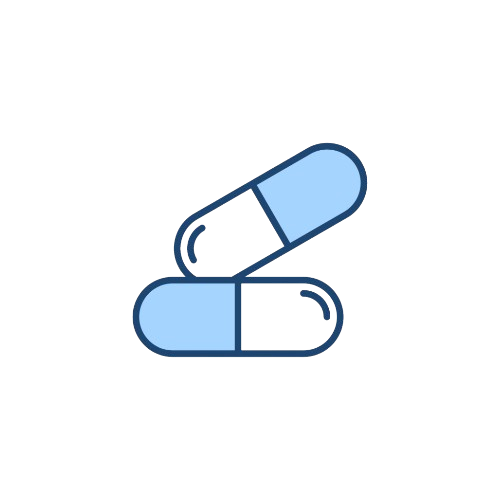Dipyridamole
Medicines List
All MedicineIndications
Approved Indications:
- Secondary prevention of thromboembolic events:
- In combination with aspirin to reduce the risk of stroke in patients with a history of transient ischemic attack (TIA) or completed ischemic stroke.
- Adjunct in prosthetic heart valve management:
- As an antiplatelet agent to prevent thromboembolism in patients with mechanical heart valves, often with oral anticoagulants.
- Pharmacologic stress testing:
- As a coronary vasodilator in myocardial perfusion imaging for patients unable to exercise adequately.
Off-label / Clinically Accepted Uses:
- Peripheral arterial disease (PAD):
- May be used to improve limb blood flow when other antiplatelet therapies are insufficient.
- Prevention of venous thromboembolism (VTE):
- In selected high-risk patients (e.g., post-orthopedic surgery) when standard therapies are contraindicated.
Dosage & Administration
Oral Route:
- Stroke Prevention (in combination with aspirin):
- Extended-release dipyridamole + aspirin: 200 mg dipyridamole + 25 mg aspirin orally twice daily
- Swallow whole; do not crush or chew
- Prosthetic Heart Valve Thromboprophylaxis:
- Immediate-release dipyridamole: 75–100 mg orally four times daily
- Often used with warfarin
Intravenous Route (for stress testing):
- Myocardial Perfusion Imaging (MPI):
- 0.56 mg/kg IV infusion over 4 minutes (0.14 mg/kg/min)
- Radiotracer is administered 3–5 minutes post-infusion
Pediatric Use:
- Not routinely recommended; data limited for efficacy/safety
Elderly:
- No routine dose adjustment required; monitor for hypotension and dizziness
Renal/Hepatic Impairment:
- No dosage adjustment generally needed, but caution advised due to altered hemodynamics
Mechanism of Action (MOA)
Dipyridamole acts primarily as a phosphodiesterase (PDE) inhibitor, increasing intracellular concentrations of cyclic adenosine monophosphate (cAMP) and cyclic guanosine monophosphate (cGMP) in platelets, thereby inhibiting platelet aggregation. It also inhibits the reuptake and metabolism of adenosine, increasing extracellular adenosine levels, which act on A2 receptors in vascular smooth muscle to produce vasodilation. These combined effects reduce platelet aggregation and improve blood flow, making it effective in stroke prevention and pharmacologic stress testing.
Pharmacokinetics
- Absorption: Rapid but variable; enhanced by food
- Bioavailability: ~37–66% for immediate-release; improved with extended-release formulations
- Distribution: Widely distributed; plasma protein binding >90%
- Metabolism: Primarily hepatic, via conjugation to glucuronide metabolites
- Half-life:
- Immediate-release: ~10 hours
- Extended-release: ~13 hours
- Elimination:
- Mainly via bile and feces
- Minimal renal excretion (<5%)
Pregnancy Category & Lactation
- Pregnancy:
- FDA Pregnancy Category B
- Animal studies show no fetal harm; human data are limited
- Use only if clearly needed
- Lactation:
- Unknown if dipyridamole is excreted in human milk
- Use caution when administering to breastfeeding women
Therapeutic Class
- Primary Class: Antiplatelet agent
- Subclass: Phosphodiesterase inhibitor / Adenosine uptake inhibitor
- Other Roles: Coronary vasodilator (in stress testing)
Contraindications
- Known hypersensitivity to dipyridamole or any component of the formulation
- Severe hypotension or unstable angina (for IV use in stress testing)
- Active bleeding disorders or peptic ulcer (when used with aspirin)
- Severe hepatic insufficiency (relative contraindication for oral forms)
Warnings & Precautions
- Coronary artery disease: IV dipyridamole may cause angina or myocardial infarction; use with caution
- Hypotension: Vasodilatory effects may cause dizziness or syncope, particularly in elderly or volume-depleted patients
- Bleeding risk: Increases with concurrent use of anticoagulants or antiplatelets
- Bronchospasm: Rarely observed in asthmatic patients during IV use
- Hepatic impairment: Increased drug exposure possible; monitor closely
Side Effects
Common:
- CNS: Headache, dizziness
- GI: Nausea, diarrhea
- Cardiovascular: Hypotension, flushing
- Musculoskeletal: Arthralgia, myalgia
Less Common:
- Rash, fatigue, abdominal pain, vomiting
Serious / Rare:
- Angina, bronchospasm, arrhythmias (IV use)
- Bleeding complications (especially when combined with aspirin or anticoagulants)
- Hypersensitivity reactions (e.g., urticaria, angioedema)
Onset: Usually within hours of administration; headaches may persist for several days during early use
Drug Interactions
- Adenosine: IV dipyridamole potentiates adenosine effects; reduce adenosine dose when co-administered
- Antiplatelets/Anticoagulants: Increased bleeding risk when combined with aspirin, clopidogrel, warfarin
- Cholinesterase inhibitors (e.g., donepezil): Possible antagonistic effects due to dipyridamole’s anticholinesterase activity
- Antihypertensives: May increase risk of hypotension when co-administered
- Enzymes Involved: Primarily non-CYP hepatic metabolism; not a CYP450 substrate
Recent Updates or Guidelines
- Stroke prevention guidelines (AHA/ASA): Continue to recommend aspirin + extended-release dipyridamole as an option for secondary stroke prevention
- ESC & NICE guidelines: Recognize dipyridamole as an antiplatelet alternative in select patients
- Pharmacologic stress testing protocols: IV dipyridamole remains a valid agent, though adenosine and regadenoson are often preferred
Storage Conditions
- Tablets (Immediate/Extended-Release):
- Store at 20°C to 25°C (68°F to 77°F)
- Protect from excessive moisture and heat
- Keep in tightly closed container
- IV Solution:
- Store refrigerated at 2°C to 8°C (36°F to 46°F)
- Protect from light
- Do not freeze
- Use immediately after dilution or follow manufacturer guidelines
